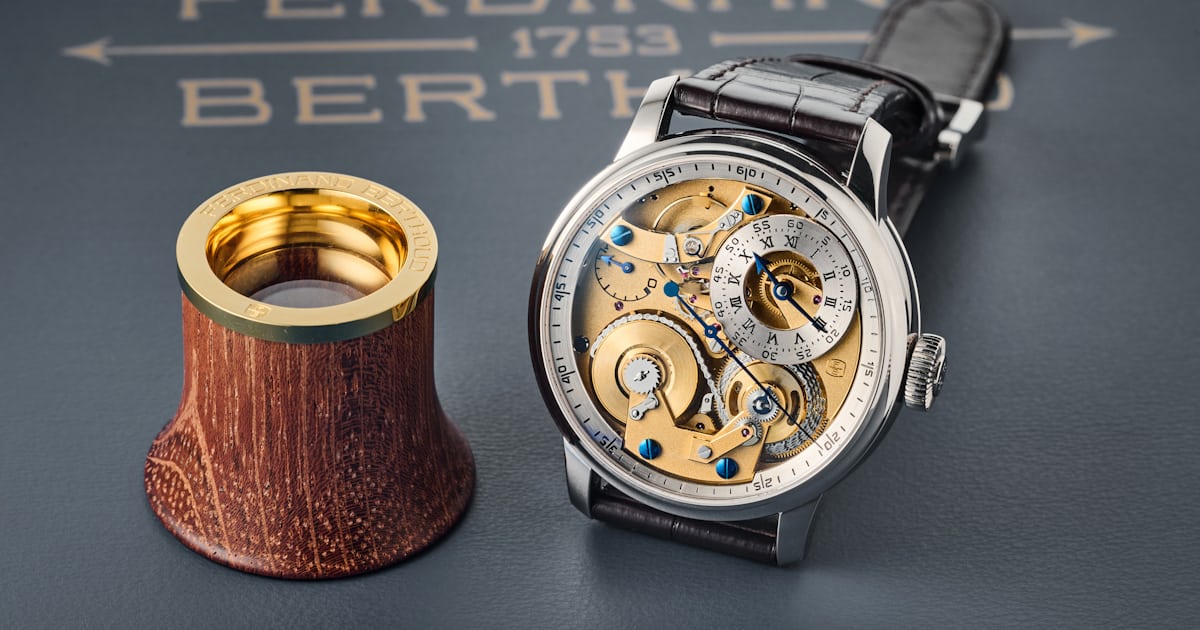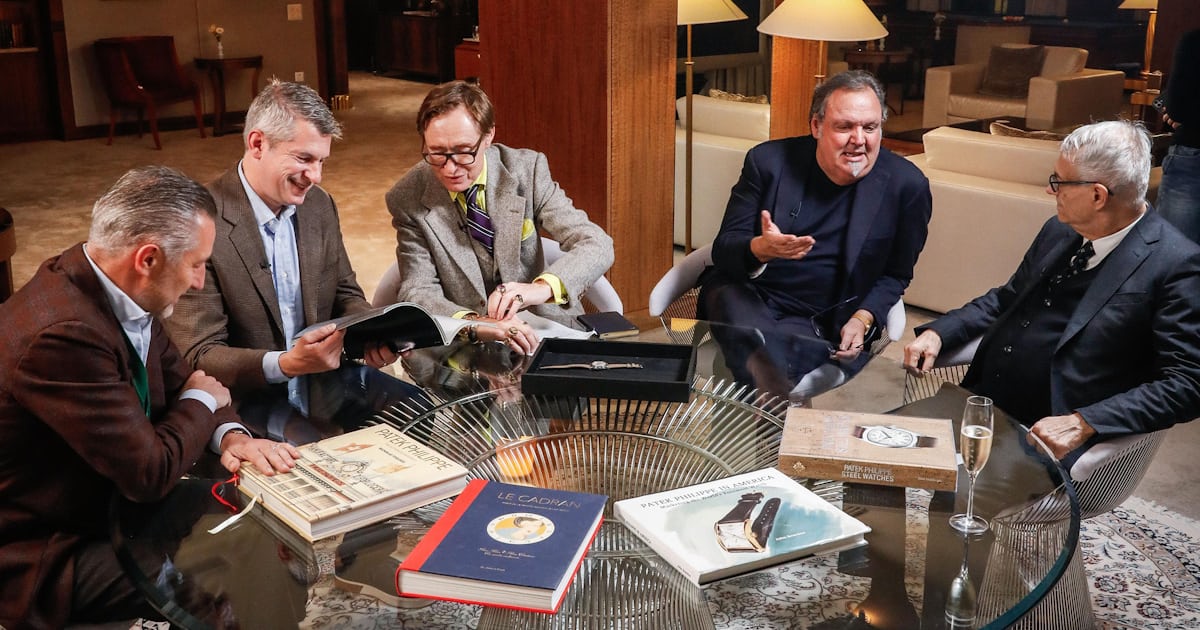Editor’s pick — Accessory quick take: key highlight (movement/specs for watches, materials/finish, limited run, pricing tier) in 1–2 lines.

In early September, Ferdinand Berthoud announced something remarkable in modern watchmaking: a fully handmade watch. The growth of passion and interest in independent watchmaking over the last few years has created a somewhat muddy description of both the word “independent” and what makes some of these watchmakers so special. Ferdinand Berthoud’s Naissance d’une Montre 3 (or “Birth of a Watch”) is both self-explanatory in its tremendous quality and yet hard to comprehend in its nature as something that few people or brands are capable of doing anymore. I knew I had to see the watch, furthered by a push from Philippe Dufour, whom I ran into on a street in Geneva, and who encouraged me to make the time.

A collector recently asked me, “What makes Rexhep Rexhepi, Roger Smith, and Philippe Dufour’s watches so great? Rexhep makes his watches by hand, right?” That prompted me to pause, fill time with “umms” and “uhhs” until I came up with a clear answer. It’s a subtle mix of technique and perspective, independence from larger brands, and the ability to do what you think is best for the art of watchmaking—and to do it at the highest possible level of design and finishing, nearly impossible for even other great watchmakers to recreate. But no, they don’t do so without modern technology, CNC machines, and the like. But Ferdinand Berthoud just did, and did something no one has ever done before.
As part of the broader Naissance d’une Montre project, organized by the Time Æeon Foundation (the origins of which I’ll explain in a moment), the idea is to rediscover and teach endangered techniques that would allow authentic, pure, unadulterated watchmaking in an antique style, preserving and protecting knowledge. The result here, made using hand-powered tools, is nothing short of the best of watchmaking past, present, and likely future. The series is limited to 11 pieces and already sold out, but as the prototype (made in steel) will be auctioned off on November 8th at Phillips (with some of the proceeds going to the Time Æon Foundation), there’s still a chance to get one of the best watches of the year.
The History of the Naissance d’une Montre Project
Early in my watch-writing career, I had the pleasure of meeting Philippe Dufour and spending an hour and a half in a casual conversation about anything that moved us at the time. “I’m worried about the future of watchmaking,” he told me, though I’m paraphrasing. “If I could do anything, I’d love to start a graduate program that would teach students to do something like that again. We could have all the great watchmakers teaching courses. But no one has the time, myself included.”
Perhaps not just in that moment, but in general, the future has been a source of concern for Dufour and other renowned watchmakers. It’s why Rexhep Rexhepi recently started an apprentice training program. Modern watchmaking has created an insatiable beast, growing the demand for mechanical watches yet again (despite the quartz crisis). At the same time, the system itself has required less and less knowledge. Processes have become automated. Students now learn general principles but are expected to spend the bulk of their career doing one small part of the process over and over. We were speaking about the “old days” of the 1910s and 1920s, when students made tremendously complicated watches from scratch, drawing inspiration from their own minds

The first Naissance d’une Montre. Photo courtesy Greubel Forsey and Time Æon Foundation.
The Naissance d’une Montre project is, in some ways, a solution to that problem. It began in 2009, also coinciding with a market renaissance, when buyers became increasingly educated about everything from the creation of a watch to its history of watchmaking, as well as the difficulty (and, on occasion, importance) of high-end finishing. The concept was simple: create a handmade watch. No electro-erosion, CNC, computerized assistance, or any of the other technologies that watchmakers now take for granted could be used.
By placing oversight under the Time Æon Foundation, the project doesn’t have any commercial incentive to compromise or break the rules for ease of creation. The first watch (shown above) was crafted by Michel Boulanger, under the direction of Greubel Forsey and Philippe Dufour, in 10 examples. That set the tone for Greubel Forsey’s creation of their Hand Made 1 (and later Hand Made 2), which follow the same principles and are held up as benchmarks of doing something (in the words of President John F. Kennedy) “not because they are easy, but because they are hard.”

The Greubel Forsey Hand Made 1. Photo courtesy Watches by SJX.

The Greubel Forsey Hand Made 2 from our Hands-On earlier this year.
The Naissance d’une Montre 2 took on a very different look. Montre 2 was started in 2015 by Dominique Buser and Cyrano Devanthey, once again taking guidance from Greubel Forsey and (this time) Urwerk. When it was released in 2019, the project’s leaders also announced that Ferdinand Berthoud would take over for part three.

Naissance d’une Montre 2. Photo courtesy of Phillips.

The Naissance d’une Montre 3
The newest edition of Naissance d’une Montre is, by far, the most harmonious watch in the project yet, with a design defined solely by the codes of Ferdinand Berthoud. Past collaborative efforts have, on their own, justified a creative approach to aesthetics. This time, by encapsulating the entire effort within one brand (and their collaborations with Chopard watchmakers), the result is more unified. It’s also so immaculate that it’s otherwise impossible to tell it’s handmade. But Ferdinand Berthoud did a great job of documenting the project, not just for our own edification but also to provide context for the fact that every part of this watch is hand-cut, turned, polished, shaped, and more.


Photo courtesy Ferdinand Berthoud.

Photo courtesy Ferdinand Berthoud.
It’s worth a brief explanation of the watch’s technical principles. The fusée-and-chain system was first implemented in clocks in the 15th Century to equalize uneven power draw as the mainspring winds down. A mainspring has more power when fully wound and less when it’s near empty. To equalize this, the mainspring-powered barrel (here, at left) is connected via a tiny chain to a tapered cone. At full power, the chain is pulled from the top of the cone, evening out the draw; as power decreases, the broader part of the cone provides more leverage. It’s an ingenious solution, but also a tedious one. The chains themselves are very difficult to make, even with industrial tools, and somewhat fragile. A fusée-and-chain wasn’t housed in a wristwatch until the 1994 release of the Tourbillon Pour Le Mérite by A. Lange & Söhne.
My inclusion of a gratuitous number of macro photos here doesn’t necessarily have any point except to show the fantastic finishing and let you see the quality for yourself. For example, we can examine the fusée-and-chain constant-force mechanism, which provides the watch with a 50-hour power reserve.

This is a mechanism that FB has been creating for over a decade as a wristwatch, but never before in this specific set of skills in handmade form. Each link in the chain is tiny and difficult to make, even industrially, and is generally impractical for a modern watch. This chain is similar to those used by Zenith and Lange (172mm compared to 180mm and 150mm, respectively), but requires much more effort. There are 285 links, each handmade, which, in total, use 191 pins measuring only 0.3 mm in diameter.


The time display is legible despite the small size. The watch, in the marine chronometer style for which FB is known, places the display focus on the long yet delicate blued central seconds hand, which runs along the dial flange, crafted in white gold. All the indices, whether the seconds or the main time display, are engraved freehand.
In the photos below, you can also see the split bi-metallic Guillaume balance. Throughout the history of watchmaking, friction, moisture, and temperature have been the main enemies of reliability. Temperature fluctuations can wreak havoc on hairsprings, especially those made before the introduction of more temperature-stable alloys, and accuracy was a life-or-death issue in the era of marine chronometers. To compensate, in the 1700s, watchmakers began using a combination of materials for balances, a practice Ferdinand Berthoud quickly adopted. Charles-Edouard Guillaume’s breakthrough in 1899 (creating a new alloy for bi-metallic balances) was so remarkable that it not only lowered temperature errors from 1.9 to 0.3 seconds per day, but he also received a Nobel Prize for his effort.

The aims of the Naissance d’une Montre are focused on the recovery and preservation of lost techniques. In a world where stable alloys exist, a Guillaume balance doesn’t serve any practical purpose. Relearning how to make one, then, required an incredible effort from the brand. What’s perhaps more impressive is that the Naissance d’une Montre 3 actually passed COSC certification; it is a chronometer in every sense of the word. I would imagine (though someone please correct me if I’m wrong) that, in addition to being the first Naissance d’une Montre watch in the 18 years of the project to be COSC-certified, it may also be the first fully handmade watch to undergo that certification. I’m also almost sure that it’s the first watch with a bi-metallic balance to pass the modern rigors of the test.

Photo courtesy Ferdinand Berthoud.



Photo courtesy Ferdinand Berthoud.
The rear of the watch is a bit simpler, though nonetheless impressive. The watch’s plates are made of German silver, featuring a sandblasted finish, a style more commonly found on French and English watches of Berthoud’s period, rather than the modern Swiss approach to finishing. The plates, bridges, and internal portions of the gears are all expertly finished with anglage. The plates are gilded, giving the entire watch a cohesive aesthetic that, on the dial side, contrasts with the white gold time-telling display.
Some screws are blued, while parts like the steel winding click feature more contemporary inner angles and highly polished, mirror-like surfaces. On the front and rear, you can see the natural diamond end-stones used to cap the balance pivot, held in place by hand-made shock absorbers. The rear plate reveals the lower portions of the fusée-and-chain mechanism, above which is engraved (in French), “Dedicated to time, the great teacher.”


Photo courtesy Ferdinand Berthoud.

Photo courtesy Ferdinand Berthoud.


The case is a more traditional round case made in white gold, with lugs that are screwed and soldered into the caseband. The entire package measures 44.3mm by 13mm, 0and while the thickness is reasonable, the diameter doesn’t seem nearly as imposing as the number suggests. While far from the most practical watch (from production method to legibility), it is surprisingly wearable. In addition, the watch also carries 30m of water resistance. And the crown, which measures 8.8mm, gives a good bit of purchase for winding.
The winding is incredibly satisfying in general. A fusée-and-chain has a particular feel when you turn the crown; the tension and shape of the chain give a very satisfying ratcheting click. A fusée-and-chain differs from a normal mainspring as it winds in one direction and unwinds in another. It’s important to keep tension and power going to the watch while the power is winding in the other direction. Within the fusée cone is a secondary spring that can impart power, even during the winding process, for a spare half hour of power reserve.



The brand will produce 10 pieces in white gold and one in stainless steel, which is being auctioned off on November 8 at Phillips. Each watch takes around 11,000 hours to produce, with around 80 people at Ferdinand Berthoud and Chopard involved in the process. Delivery will take place over a period of a few years, but that’s no problem for the buyers. All 10 have already sold, with a list price of CHF850,000, or just over $1,060,000. It’s hard to discuss value at that price, but what is clear is that you’re getting something truly special as both an object and an encapsulation of history.

For more on the Naissance d’une Montre project, visit the TimeÆon Foundation. For more on the Ferdinand Berthoud Naissance d’une Montre 3, visit the brand’s website. For the upcoming sale of the NdM3 Prototype, visit Phillips.
Source: www.hodinkee.com — original article published 2025-11-05 16:05:00.
Read the full story on www.hodinkee.com → [source_url]



